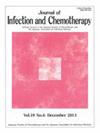Rapid and simple detection of extended spectrum β-lactamase, metallo β-lactamase, and AmpC β-lactamase using drug susceptibility testing microfluidic (DSTM) method and its applicability for blood culture specimens
IF 1.5
4区 医学
Q3 INFECTIOUS DISEASES
引用次数: 0
Abstract
Background
The recent global increase in the prevalence of antibiotic-resistant bacteria and the lack of development of new antimicrobials emphasize the importance of rapid antimicrobial selection for the treatment of infections. Matsumoto et al. (2016) proposed an innovative rapid method for drug susceptibility testing for Pseudomonas aeruginosa that provides results in 3 h. Subsequently, in a similar Drug Susceptibility Testing Microfluidic device (DSTM), we developed a rapid method to detect extended-spectrum β-lactamase, metallo β-lactamase, and AmpC β-lactamase simultaneously.
Methods
When three types of inhibitors (clavulanic acid, EDTA, and cloxacillin) were combined with β-lactamase sensitive substrate, e.g., ceftriaxone together, strains that produce any of these three classes of β-lactamases become susceptible and when one of the three is missing, only strains producing β-lactamase sensitive to the missing inhibitor grow normally. Susceptibilities were microscopically evaluated from elongated cell shapes. Enzyme classes were identified by testing to determine which inhibitors the strains were resistant to when deficient.
Results
Multiple enzyme producers were easily identified by this method. Twenty-one genome-sequenced strains of carbapenem-resistant Escherichia coli were tested, and it was confirmed that chromosomal AmpC was not involved in E. coli's carbapenem resistance. Direct blood culture testing was possible by a simple pretreatment of the culture.
Conclusion
Rapid detection of β-lactamases via this method could be useful for the infectious treatment approach.
药敏微流控(DSTM)法快速简便检测β-内酰胺酶、金属β-内酰胺酶和AmpC β-内酰胺酶及其在血液培养标本中的适用性
背景:最近全球抗生素耐药菌流行率的增加和新抗菌素开发的缺乏强调了快速选择抗菌素对感染治疗的重要性。Matsumoto等人(2016)提出了一种创新的铜绿假单胞菌药敏快速检测方法,可在3小时内提供结果。随后,在类似的药敏检测微流控装置(DSTM)中,我们开发了一种同时检测广谱β-内酰胺酶、金属β-内酰胺酶和AmpC β-内酰胺酶的快速方法。方法:当三种抑制剂(克拉维酸、EDTA、氯西林)与β-内酰胺酶敏感底物(如头孢曲松)联合使用时,产生这三种β-内酰胺酶中的任何一种的菌株都变得敏感,当缺少其中一种抑制剂时,只有产生对缺失的β-内酰胺酶敏感的菌株生长正常。从细长的细胞形状在显微镜下评估其敏感性。酶的种类是通过测试来确定哪些抑制剂菌株在缺乏时是耐药的。结果:该方法易于鉴定多种产酶产物。对21株碳青霉烯耐药大肠杆菌进行了基因组测序,证实染色体AmpC与大肠杆菌碳青霉烯耐药无关。通过对培养物进行简单的预处理,可以实现直接血培养试验。结论:利用该方法快速检测β-内酰胺酶,可为感染性治疗提供参考。
本文章由计算机程序翻译,如有差异,请以英文原文为准。
求助全文
约1分钟内获得全文
求助全文
来源期刊

Journal of Infection and Chemotherapy
INFECTIOUS DISEASES-PHARMACOLOGY & PHARMACY
CiteScore
4.10
自引率
4.50%
发文量
303
审稿时长
47 days
期刊介绍:
The Journal of Infection and Chemotherapy (JIC) — official journal of the Japanese Society of Chemotherapy and The Japanese Association for Infectious Diseases — welcomes original papers, laboratory or clinical, as well as case reports, notes, committee reports, surveillance and guidelines from all parts of the world on all aspects of chemotherapy, covering the pathogenesis, diagnosis, treatment, and control of infection, including treatment with anticancer drugs. Experimental studies on animal models and pharmacokinetics, and reports on epidemiology and clinical trials are particularly welcome.
 求助内容:
求助内容: 应助结果提醒方式:
应助结果提醒方式:


